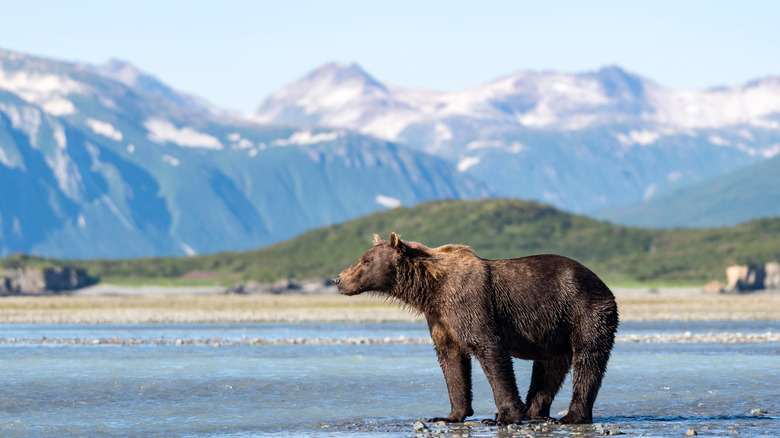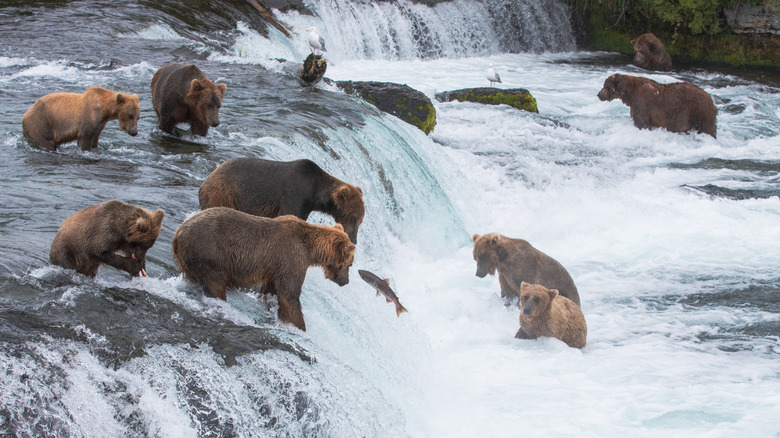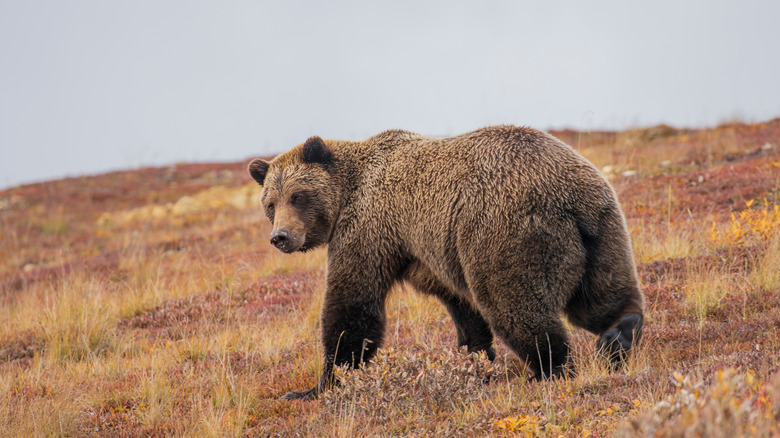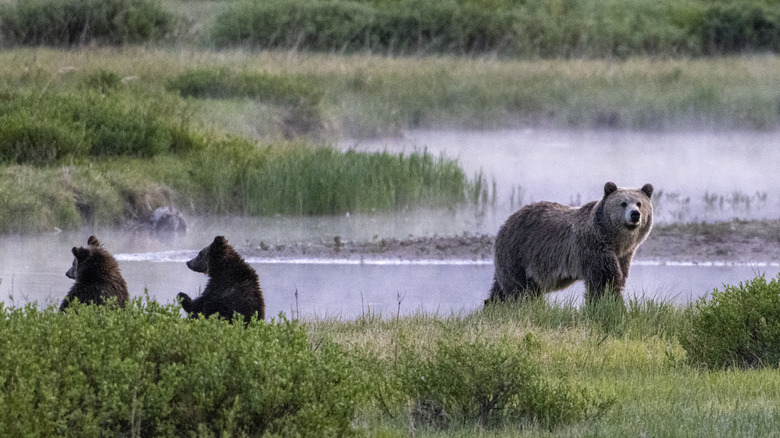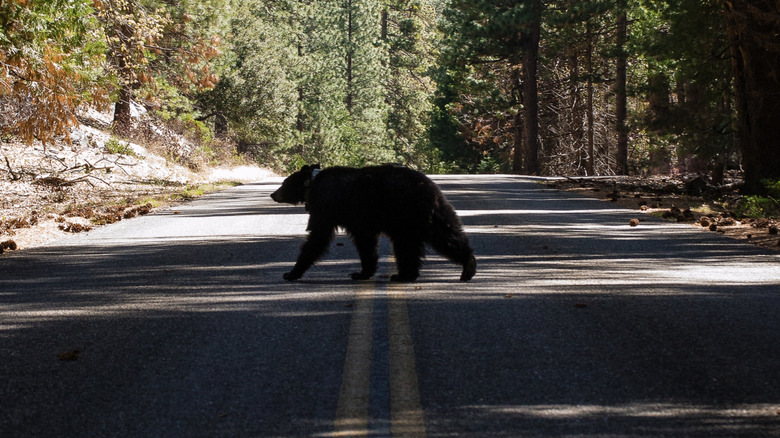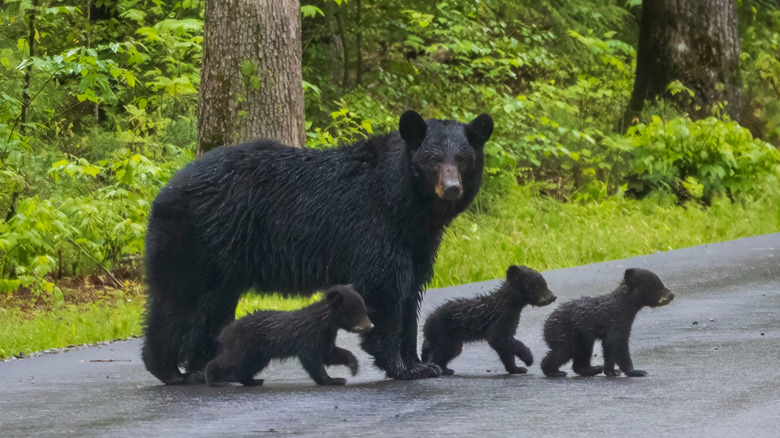National Parks Where You're Almost Guaranteed To See A Bear
There's nothing quite like seeing a bear roaming free through its natural habitat. While coming across one when you aren't expecting it can be a terrifying experience, for many national park visitors, spotting one of these incredible creatures is the highlight of their trip. There are many, many parks and preserves around the United States where bears live, from the polar bears at the Bering Land Bridge National Preserve to the black bears at Everglades National Park, but for such enormous animals, they can be surprisingly elusive.
If you're hoping to catch a glimpse of a bear on your next vacation, consider heading to Alaska to visit either Katmai National Park & Preserve or Denali National Park, California's Sequoia & Kings Canyon National Parks, the border of North Carolina and Tennessee for Great Smoky Mountains National Park, or the iconic Yellowstone National Park, which sprawls across Wyoming, Montana, and Idaho.
As thrilling as it is to see wild animals, the National Park Service advises caution to ensure that it's a safe experience for both you and the bear. As part of that precaution, you should always stay 300 feet from bears and stick to the trail whenever you can. If you do happen upon a bear unexpectedly, stay calm, make noise, pick up any children hiking with you, and slowly move away from the animal in a sideways direction.
Katmai National Park & Preserve
Many national parks have bears, but this one is world famous because of its bears. Katmai National Park & Preserve, an iconic national park in Alaska, is home to the internet's favorite wildlife thanks to the park's seasonal livestream of Brooks Falls, a favorite fishing spot for brown bears, and the annual Fat Bear Week fan vote to determine which bear has gained the most weight before hibernation. This may be the single best place in the world to see a brown bear in the wild. There are around 2200 brown bears living in the park, and during peak salmon times, a staggering 50 bears have been seen eating in the same section of the river. Even though you can see it on the livestream, every year people travel here from around the world to see it for themselves.
The best time to see Katmai's bears is in July, but if you visit any time from mid-spring to mid-fall, you're still very likely to see one or two. You can explore Katmai's backcountry, but the best place to see the bears is known as Brooks Camp, where there are platforms set up for visitors to watch the bears fishing in the falls. This provides you with a rare opportunity to get relatively close to one without endangering yourself or the animals. Getting to Brooks Falls can be tricky, however. To visit for the day, you'll probably need to fly in on a special flight (like Fly Rusts or Alaska Bear Adventures) or fly to the appropriately named King Salmon and take a water taxi to Brooks Camp.
Denali National Park & Preserve
If you want to see grizzly bears running through the bright red wild blueberry and dwarf birch against a backdrop of rugged mountain peaks, you can't go wrong with a trip to Alaska's Denali National Park. It's believed that there are more than 300 grizzlies and around 200 black bears in this area. Summer is the most popular time to visit Denali in general, and it's also the perfect time to visit if you want to see a foraging grizzly eating as much as they can before hibernation. While it's usually easier to see animals around dusk or dawn, in national parks these hungry bears have no fear. As a result, most people spot them between 10 a.m. and 4 p.m.
Denali National Park is an unbelievable 8.5 million acres — an area bigger than the state of New Jersey — but there's only one road in the entire park. While you can hike through its backcountry, one of the best ways to explore Denali (especially on a tight budget) is to take a non-narrated transit bus along the road. Although there's no way to be 100% certain that you'll see a bear, you have a good shot from the high vantage point of the bus and the advantage of having the rest of the passengers looking with you. Plus, if there is a bear visible from the bus, drivers may get a heads up from other bus drivers on the road, so you'll know to keep your eyes out in a particular area.
Yellowstone National Park
From colorful geothermal pools to herds of bison, there's plenty to see in America's first national park, Yellowstone, and if you're looking to see a bear, you're in luck. Spotting bears while driving through Yellowstone is one of the most popular activities in the park — to the point that the park has an issue with traffic jams caused by cars stopping in the road to watch the massive animals. There are believed to be around 150 black bears in the park and between 150-200 grizzly bears, with more than 700 more living in the wider region. Just don't get too close! There are a lot of upsetting tourist mistakes people make in Yellowstone, but the worst one might be trying to take a selfie with a wild animal like a grizzly bear.
If you want to see a grizzly, your best bet is to go to explore the park at either dawn or dusk when it's a little cooler. Grizzlies and black bears alike frequent Hayden Valley and Lamar Valley. The easiest way to explore these regions is to drive to a pullout with higher elevation and look out at the valley below for signs of bears coming out of the forest. You may also have luck on the north side of Mount Washburn, on the shores of Yellowstone Lake, near Mammoth Hot Springs, or in the area between Fishing Bridge and the East Entrance of the park.
Sequoia & Kings Canyon National Parks
While people often travel to Sequoia & Kings Canyon National Parks to see the mighty trees that grow there, these twin California parks offer many visitors a chance to see typically evasive black bears in the wild. As one national park enthusiast on Reddit stated, "[I've] seen bear in many places, but Kings Canyon was the beariest place we've ever been."
It can be hard to nail down exactly how many of these shy creatures live in the park, but in 2019, it was believed there were as many as 800 black bears living and foraging in this region. According to park visitors, the campsites often have bears nosing around. Because of this, it's vital to secure your food in bear-safe containers so that you don't attract them, and chase them off if you do happen to see them in areas where humans often are, for their own safety. Unfortunately, bears who come to see humans as a food source are more likely to be hit by cars, even in a national park.
A much better way to see bears in these underrated and uncrowded California national parks is to seek out the places where their food is at different times of year. In the spring, they'll be digging in the meadows; in the summer, they'll be gorging themselves on berry bushes; and in the fall, they'll be up in oak trees snacking on acorns. If you're looking for the perfect meadows to look for springtime foragers, head to either Crescent Meadow or Halstead Meadow around dusk or dawn. Remember to speak and walk quietly; when they realize you're there, the bears will probably leave.
Great Smoky Mountains National Park
If you're looking for East Coast bear country, your best bet may be the Great Smoky Mountains. This wild, forested area is the perfect habitat for black bears, and it's believed that there may be an incredible 1900 bears that make their home there. You'll primarily see them in the spring and summer, around sunrise or sunset. While there are bears everywhere in the park, if you're hoping to see some for yourself, your best bet is to head to Cades Cove. This area is teeming with wildlife, so even if you don't happen to spot one of the bears that frequent it, you're likely to see some other interesting animals.
Best of all, this region is accessible by the Cades Cove Loop Road, which has many pullouts to stop and watch from, so you can cover a lot of ground while looking for bears. As long as you stay in your car, you can view them safely, too. If you're walking through the area, a good rule of thumb is to use your actual thumb to assess if you're too close to an animal. Just raise your arm out straight in front of you and see if you can completely obscure the animal with your thumb. If you can't, you're probably too close to that creature — especially if it happens to be a bear!
